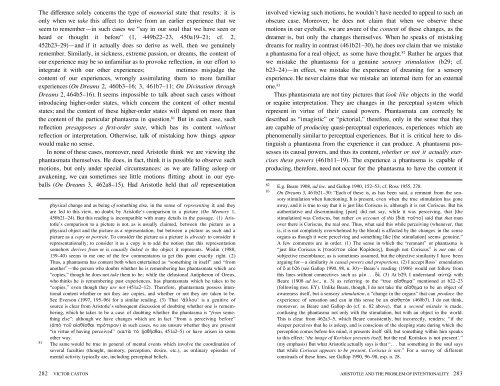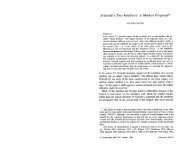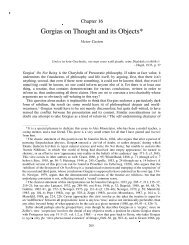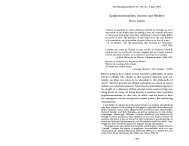Aristotle and the Problem of Intentionality. - Ancient Philosophy ...
Aristotle and the Problem of Intentionality. - Ancient Philosophy ...
Aristotle and the Problem of Intentionality. - Ancient Philosophy ...
Create successful ePaper yourself
Turn your PDF publications into a flip-book with our unique Google optimized e-Paper software.
The difference solely concerns <strong>the</strong> type <strong>of</strong> memorial state that results: it isonly when we take this affect to derive from an earlier experience that weseem to remember—in such cases we “say in our soul that we have seen orheard or thought it before” (1, 449b22–23, 450a19–21; cf. 2,452b23–29)—<strong>and</strong> if it actually does so derive as well, <strong>the</strong>n we genuinelyremember. Similarly, in sickness, extreme passion, or dreams, <strong>the</strong> content <strong>of</strong>our experience may be so unfamiliar as to provoke reflection, in our effort tointegrate it with our o<strong>the</strong>r experimetimes misjudge <strong>the</strong>content <strong>of</strong> our experiences, wrongly assimilating <strong>the</strong>m to more familiarexperiences (On Dreams 2, 460b3–16; 3, 461b7–11; On Divination throughDreams 2, 464b5–16). It seems impossible to talk about such cases withoutintroducing higher-order states, which concern <strong>the</strong> content <strong>of</strong> o<strong>the</strong>r mentalstates; <strong>and</strong> <strong>the</strong> content <strong>of</strong> <strong>the</strong>se higher-order states will depend on more than<strong>the</strong> content <strong>of</strong> <strong>the</strong> particular phantasma in question. 81 But in each case, suchreflection presupposes a first-order state, which has its content withoutreflection or interpretation. O<strong>the</strong>rwise, talk <strong>of</strong> mistaking how things appearwould make no sense.In none <strong>of</strong> <strong>the</strong>se cases, moreover, need <strong>Aristotle</strong> think we are viewing <strong>the</strong>phantasmata <strong>the</strong>mselves. He does, in fact, think it is possible to observe suchmotions, but only under special circumstances: as we are falling asleep orawakening, we can sometimes see little motions flitting about in our eyeballs(On Dreams 3, 462a8–15). Had <strong>Aristotle</strong> held that all representationphysical change <strong>and</strong> as being <strong>of</strong> something else, in <strong>the</strong> sense <strong>of</strong> representing it; <strong>and</strong> <strong>the</strong>yare led to this view, no doubt, by <strong>Aristotle</strong>’s comparison to a picture (On Memory 1,450b21–24). But this reading is incompatible with many details in <strong>the</strong> passage. (1) <strong>Aristotle</strong>’scomparison to a picture is not, as is usually claimed, between <strong>the</strong> picture as aphysical object <strong>and</strong> <strong>the</strong> picture as a representation, but between a picture as such <strong>and</strong> apicture as a copy or portrait. To consider <strong>the</strong> picture as a picture is already to consider itrepresentationally; to consider it as a copy is to add <strong>the</strong> notion that this representationsomehow derives from or is causally linked to <strong>the</strong> object it represents. Wedin (1988,139–40) seems to me one <strong>of</strong> <strong>the</strong> few commentators to get this point exactly right. (2)Thus, a phantasma has content both when entertained as “something in itself” <strong>and</strong> “fromano<strong>the</strong>r”—<strong>the</strong> person who doubts whe<strong>the</strong>r he is remembering has phantasmata which are“copies,” though he does not take <strong>the</strong>m to be; while <strong>the</strong> delusional Antipheron <strong>of</strong> Oreus,who thinks he is remembering past experiences, has phantasmata which he takes to be“copies,” even though <strong>the</strong>y are not (451a2–12). Therefore, phantasmata possess intentionalcontent whe<strong>the</strong>r or not <strong>the</strong>y are copies, <strong>and</strong> whe<strong>the</strong>r or not <strong>the</strong>y are taken to be.See Everson (1997, 195–96) for a similar reading. (3) That ‘êllou’ is a genitive <strong>of</strong>source is clear from <strong>Aristotle</strong>’s subsequent discussion <strong>of</strong> doubting whe<strong>the</strong>r one is remembering,which he takes to be a case <strong>of</strong> doubting whe<strong>the</strong>r <strong>the</strong> phantasma is “from somethingelse”: although we have changes which are in fact “from a perceiving before”(épÚ toË afisy°syai prÒteron ) in such cases, we are unsure whe<strong>the</strong>r <strong>the</strong>y are present“in virtue <strong>of</strong> having perceived” (katå tÚ ºsy∞syai, 451a2–5) or have arisen in someo<strong>the</strong>r way.81 The same would be true in general <strong>of</strong> mental events which involve <strong>the</strong> coordination <strong>of</strong>several faculties (thought, memory, perception, desire, etc.), as ordinary episodes <strong>of</strong>mental activity typically are, including perceptual beliefs.involved viewing such motions, he wouldn’t have needed to appeal to such anobscure case. Moreover, he does not claim that when we observe <strong>the</strong>semotions in our eyeballs, we are aware <strong>of</strong> <strong>the</strong> content <strong>of</strong> <strong>the</strong>se changes, as <strong>the</strong>dreamer is, but only <strong>the</strong> changes <strong>the</strong>mselves. When he speaks <strong>of</strong> mistakingdreams for reality in contrast (461b21–30), he does not claim that we mistakea phantasma for a real object, as some have thought. 82 Ra<strong>the</strong>r he argues thatwe mistake <strong>the</strong> phantasma for a genuine sensory stimulation (b29; cf.b23–24)—in effect, we mistake <strong>the</strong> experience <strong>of</strong> dreaming for a sensoryexperience. He never claims that we mistake an internal item for an externalone. 83Thus phantasmata are not tiny pictures that look like objects in <strong>the</strong> worldor require interpretation. They are changes in <strong>the</strong> perceptual system whichrepresent in virtue <strong>of</strong> <strong>the</strong>ir causal powers. Phantasmata can correctly bedescribed as “imagistic” or “pictorial,” <strong>the</strong>refore, only in <strong>the</strong> sense that <strong>the</strong>yare capable <strong>of</strong> producing quasi-perceptual experiences, experiences which arephenomenally similar to perceptual experiences. But it is critical here to distinguisha phantasma from <strong>the</strong> experience it can produce. A phantasma possessesits causal powers, <strong>and</strong> thus its content, whe<strong>the</strong>r or not it actually exercises<strong>the</strong>se powers (461b11–19). The experience a phantasma is capable <strong>of</strong>producing, <strong>the</strong>refore, need not occur for <strong>the</strong> phantasma to have <strong>the</strong> content it82 E.g. Beare 1908, ad loc. <strong>and</strong> Gallop 1990, 152–53; cf. Ross 1955, 278.83 On Dreams 3, 461b21–30: “Each <strong>of</strong> <strong>the</strong>se is, as has been said, a remnant from <strong>the</strong> sensorystimulation when functioning. It is present, even when <strong>the</strong> true stimulation has goneaway, <strong>and</strong> it is true to say that it is just like Coriscus is, although it is not Coriscus. But hisauthoritative <strong>and</strong> discriminating [part] did not say, while it was perceiving, that [<strong>the</strong>stimulation] was Coriscus, but ra<strong>the</strong>r on account <strong>of</strong> this [diå toËto] said that that manover <strong>the</strong>re is Coriscus, <strong>the</strong> real one. Thus, what said this while perceiving (whenever, thatis, it is not completely overwhelmed by <strong>the</strong> blood) is affected by <strong>the</strong> changes in <strong>the</strong> senseorgans as though it were perceiving <strong>and</strong> something like [<strong>the</strong> stimulation] seems genuine.”A few comments are in order. (1) The sense in which <strong>the</strong> “remnant” or phantasma is“just like Coriscus is [toioËton oÂon Kor¤skow], though not Coriscus” is not one <strong>of</strong>subjective resemblance, as is sometimes assumed, but <strong>the</strong> objective similarity I have beenarguing for—a similarity in causal powers <strong>and</strong> proportions. (2) I accept Ross’ emendation<strong>of</strong> ˘ at b26 (see Gallop 1990, 98, n. 30)—Beare’s reading (1906) would not follow fromthis lines without connectives such as m¢n...d¢. (3) At b29, I underst<strong>and</strong> aÈt“ withBeare (1908 ad loc., n. 3) as referring to <strong>the</strong> “true a‡syhma” mentioned at b22–23(following mss. EY). Unlike Beare, though, I do not take <strong>the</strong> a‡syhma to be an object <strong>of</strong>awareness itself, but a sensory stimulation, a “change in <strong>the</strong> organs” that can produce <strong>the</strong>experience <strong>of</strong> sensation <strong>and</strong> can in this sense be an afisyhtÒn (460b3). I do not think,moreover, as Beare <strong>and</strong> Gallop do (cf. n. 82 above), that a second mistake is made,confusing <strong>the</strong> phantasma not only with <strong>the</strong> stimulation, but with an object in <strong>the</strong> world.This is clear from 462a3–5, which Beare consistently, but incorrectly, renders: “if <strong>the</strong>sleeper perceives that he is asleep, <strong>and</strong> is conscious <strong>of</strong> <strong>the</strong> sleeping state during which <strong>the</strong>perception comes before his mind, it presents itself still, but something within him speaksto this effect: ‘<strong>the</strong> image <strong>of</strong> Koriskos presents itself, but <strong>the</strong> real Koriskos is not present’.”(my emphasis) But what <strong>Aristotle</strong> actually says is that “. . . but something in <strong>the</strong> soul saysthat while Coriscus appears to be present, Coriscus is not.” For a survey <strong>of</strong> differentconstruals <strong>of</strong> <strong>the</strong>se lines, see Gallop 1990, 96–98, esp. n. 28.282 VICTOR CASTONARISTOTLE AND THE PROBLEM OF INTENTIONALITY 283





